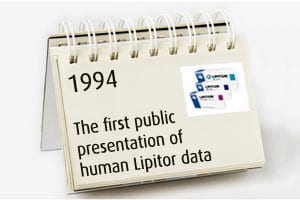 Few drugs sum up big pharma better than Lipitor – Pfizer’s enormously successful statin that became the biggest selling prescription drug in history.
Few drugs sum up big pharma better than Lipitor – Pfizer’s enormously successful statin that became the biggest selling prescription drug in history.
Launched in the late 90s after a lengthy R&D process to much fanfare as a true breakthrough medicine in managing cholesterol and preventing cardiovascular problems, Lipitor (atorvastatin) became the best-selling medicine in the world for almost a decade, helping cement Pfizer’s position as the number one global pharma company and the pharma industry as one of the world’s financially healthiest.
Its success has now become its downfall, however, with Lipitor’s place at the very top of the industry’s ‘patent cliff’ meaning Pfizer has had to rethink strategy across the company to cope with the decline in revenues since the drug lost patent protection in November 2011.
It’s a situation mirrored throughout the industry, with each company retooling in its own individual way to cope with the loss of its own ‘Lipitors’ as generic competition begins to bite for everyone.
Lipitor’s journey may be one that’s coming to an end, but it was nearly 20 years ago, at a scientific conference in Montreal held October 1994, that this future blockbuster first began to get the healthcare world’s attention.
It was there that Dr Donald Black, vice president of clinical research at the Parke-Davis division of Warner-Lambert (where the drug was originally developed), made the first public presentation of human trial data of the investigational atorvastatin, revealing results so impressive in the drug’s ability to manage cholesterol that, according to the Wall Street Journal, one senior Merck official stood up to suggest the drug be called “turbostatin”.
But as with many great discoveries in medicine, including penicillin, chemotherapy and Viagra, it’s something of a fortuitous accident that Lipitor was even developed at all.
The full story begins in the 1980s, when atorvastatin was first synthesised by Dr Bruce Roth of Warner-Lambert, although without much hope of taking the compound further into development.
However, Dr Roth and his colleagues turned their full attentions to atorvastatin once they realised the main compound they were working on was also in development by Sandoz, which had obtained a patent for it.
Dr Roth’s team continued to advance the development of atorvastatin to 1989, when the time came for executives at Parke-Davis to decide whether the compound should be advanced to clinical trials in human, despite having demonstrated it was no better than existing products in animal studies.
“There was a lot of controversy at Warner-Lambert as to whether we should even take our molecule into the clinic for human testing” Dr Roth told Associated Press in December, 2011. “It was kind of a big risk … it’s millions of dollars.”
The researchers’ main challenge was that the atorvastatin molecule had both a left- and right-hand side, but only the left-hand side was actually effective in blocking the enzymes that reduce cholesterol.
However, Dr Roth was able to create a version of the molecule that was only left-handed, which Warner-Lambert eventually figured out how to make in large batches.
Initial experiments were carried out on 24 volunteers from the company, with a 10mg dose of atorvastatin leading to a 38 per cent drop in bad cholesterol, while an 80mg dose achieved a decrease of 58 per cent – far greater than any existing statin at any dose.
These were exciting results, and further larger studies were initiated by Warner-Lambert, each continuing to demonstrate the drug’s superiority over existing treatments Merck & Co’s Zocor, Bristol-Myers Squibb’s Pravachol and Novartis’ Lescol, leading to a priority review from the US Food and Drug Administration (FDA) before Warner-Lambert filed for US approval in June 1996.
Investors were still wary of the full potential of Lipitor, prompting Warner-Lambert to partner with Pfizer to market the drug once it was launched in the US in 1997.
It was during that year that the FDA first allowed adverts for drugs that targeted consumers directly, and Pfizer spent millions on television campaigns promoting the treatment, while recommendations for optimum cholesterol levels continued to lower.
This all increased demand for the product, while superior data and a lower price compared to its rivals convinced many doctors to choose Lipitor for their patients.
Pfizer then took full control of the drug in 2000 following a buyout of Warner-Lambert for about $90bn, beating out competition from American Home Products, which had launched its own takeover bid.
It was an acquisition that paid off, with Lipitor achieving annual revenues of more than $12bn during the past decade. And all this for drug that was originally only plan B.
As Dr Roth told Associated Press: “The number of factors, internal and external, that had to come together for the drug to be a success really boggles the mind.”

Compiled by Tom Meek,
web editor at PMLiVE




